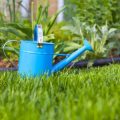1. Understanding Organic Soil Amendments
If you’re dreaming of a lush, productive backyard garden, healthy soil is the foundation. One of the best ways to build and maintain that soil is by using organic soil amendments. But what exactly are they, and why are they so important for sustainable gardening in the U.S.?
What Are Organic Soil Amendments?
Organic soil amendments are natural materials added to the soil to improve its physical properties, nutrient content, and overall health. Unlike synthetic fertilizers, which are manufactured using chemicals, organic amendments come from natural sources like composted plant material, animal manure, or ground minerals.
Organic vs Synthetic: Whats the Difference?
| Aspect | Organic Amendments | Synthetic Fertilizers |
|---|---|---|
| Source | Natural (plant, animal, mineral) | Chemically processed or man-made |
| Nutrient Release | Slow-release over time | Quick-release, immediate effects |
| Soil Health | Improves structure and microbial life | Can degrade soil quality over time |
| Sustainability | Eco-friendly and renewable | May contribute to pollution and runoff |
Why They Matter for American Backyard Gardens
In the U.S., backyard gardening is more than just a hobby—it’s a way to grow fresh produce, connect with nature, and promote environmental responsibility. Organic soil amendments support these goals by:
- Enhancing Soil Structure: They help loosen compacted soils and improve water retention.
- Nourishing Plants Naturally: Nutrients are released slowly, feeding plants over time without chemical burn risks.
- Encouraging Biodiversity: Healthy soil fosters beneficial microbes and insects.
- Reducing Environmental Impact: Less chemical runoff means cleaner waterways and a healthier ecosystem.
The Bottom Line
If youre serious about creating a thriving backyard garden in America, understanding and using organic soil amendments is a must. Theyre not only better for your plants but also better for your local environment and long-term sustainability.
2. Compost: Nature’s Ultimate Soil Booster
Compost is often called “black gold” for a reason—it’s one of the most effective and natural ways to boost your garden soil. Whether you’re growing juicy tomatoes in California or nurturing native perennials in New England, compost is a go-to amendment for gardeners across the U.S.
Why Compost Works Wonders
Compost improves your garden soil in several powerful ways:
- Improves Soil Structure: Compost helps sandy soils retain moisture and loosens up heavy clay soils, making them easier to work with.
- Adds Essential Nutrients: It slowly releases nitrogen, phosphorus, potassium, and micronutrients—perfect for long-term plant health.
- Boosts Microbial Activity: Healthy soil teems with beneficial microbes, fungi, and earthworms. Compost feeds these organisms, which in turn help plants absorb nutrients more efficiently.
What Can You Compost?
You can make compost at home with a mix of green (nitrogen-rich) and brown (carbon-rich) materials. Heres a simple guide:
| Green Materials (Nitrogen) | Brown Materials (Carbon) |
|---|---|
| Fruit & veggie scraps | Dried leaves |
| Coffee grounds | Sawdust (untreated wood) |
| Grass clippings | Torn newspaper |
| Tea bags (no staples) | Cereal boxes (shredded) |
Tips for Using Compost in Your Garden
- Mature Compost Only: Make sure your compost is fully broken down before using it. It should smell earthy, not sour or rotten.
- Till or Top-Dress: Mix compost into the top few inches of soil or apply it as a mulch around plants.
- Avoid Overdoing It: While compost is great, too much can overwhelm your soil. Aim for about 1-2 inches on top each season.
The Bottom Line on Compost
If youre looking for a budget-friendly, eco-conscious way to supercharge your backyard garden, compost is hard to beat. Its easy to make or buy and supports healthy plants from root to leaf.

3. Worm Castings and Vermicompost
Worm castings, also known as vermicompost, are often called “black gold” in the gardening world—and for good reason. These nutrient-rich droppings from composting worms are packed with beneficial microbes, enzymes, and plant-ready nutrients that can dramatically improve your soils health and structure.
Benefits of Worm Castings
Using worm castings is one of the easiest ways to give your garden a natural boost. Heres what they do for your backyard garden:
| Benefit | How It Helps Your Garden |
|---|---|
| Improves Soil Structure | Enhances aeration and water retention, making it easier for roots to grow. |
| Boosts Plant Immunity | Contains natural compounds that help plants resist pests and diseases. |
| Supplies Essential Nutrients | Packed with nitrogen, phosphorus, potassium, and trace minerals in a form plants can easily absorb. |
| Encourages Microbial Activity | Feeds beneficial soil microbes that support healthy root development. |
How to Use Worm Castings
You can use worm castings in several ways throughout your garden:
- Soil Amendment: Mix into garden beds before planting to enrich the soil.
- Top Dressing: Sprinkle around the base of plants during the growing season for an ongoing nutrient boost.
- Compost Tea: Steep worm castings in water to create a liquid fertilizer you can spray on leaves or water into the soil.
Starting Your Own Worm Composting System
You don’t need a big yard to make your own worm compost—just a small bin and some red wigglers (Eisenia fetida). Heres how to get started:
- Choose a Bin: A plastic storage container with air holes works great for indoor or outdoor use.
- Add Bedding: Use shredded newspaper or cardboard as bedding material for your worms.
- Add Worms: Red wigglers are the best composting worms and are available at many garden centers or online.
- Feed Them Right: Give them fruit and veggie scraps, coffee grounds, and crushed eggshells—avoid meat, dairy, and oily foods.
- Harvest Castings: Every few months, collect the dark, crumbly castings from one side of the bin while shifting food scraps to the other side to draw worms away.
If you’re looking for an organic way to supercharge your soil and grow healthier plants, worm castings are a must-have amendment for any American backyard garden.
4. Manure: A Traditional Powerhouse
Manure has been a go-to organic soil amendment for generations—and for good reason. It’s rich in nutrients, improves soil structure, and enhances microbial activity. But not all manure is created equal. Understanding the types of well-aged manure and how to use them safely is key to reaping the benefits without risking your plants or health.
Common Types of Manure
| Type | Pros | Cons |
|---|---|---|
| Cow Manure | Mild nutrient content; great for general use; improves soil texture | Can be bulky; low in nitrogen compared to others |
| Horse Manure | Widely available; adds organic matter quickly | Often contains weed seeds unless composted well |
| Chicken Manure | Very high in nitrogen and phosphorus; excellent for leafy greens | “Hot” when fresh—must be composted to avoid burning plants |
Why Well-Aged or Composted Manure Matters
Fresh manure can contain pathogens, weed seeds, and high levels of ammonia that may damage plants. Using well-aged or properly composted manure helps reduce these risks while still delivering valuable nutrients to your garden.
How to Safely Incorporate Manure into Your Garden Beds
- Choose composted manure: Look for bagged options labeled as “composted,” or allow raw manure to age for at least six months before using.
- Till it into the soil: Mix it into the top 6–8 inches of soil to help nutrients integrate evenly and avoid runoff.
- Apply in the off-season: For best results, apply manure in late fall or early spring so it has time to break down before planting.
- Avoid root crops initially: If applying fresh or semi-composted manure, skip planting carrots, radishes, or potatoes immediately afterward due to risk of contamination.
Quick Tip:
If you’re unsure about the strength of your manure, mix it with straw or compost before applying. This helps balance out nutrient levels and reduces the chance of plant burn.
Best Use Cases by Plant Type
- Cow manure: Best for general vegetable beds and flower gardens.
- Horse manure: Ideal for improving soil texture in large garden plots.
- Chicken manure: Perfect for heavy feeders like corn, tomatoes, and leafy greens—just make sure it’s aged!
Using manure wisely can transform tired backyard soil into a nutrient-rich foundation for healthy plants. When handled properly, its one of the most effective—and traditional—tools in any organic gardener’s toolkit.
5. Specialty Amendments: From Bone Meal to Kelp Meal
If you’re looking to give your backyard garden a serious boost, specialty organic amendments can help target specific soil and plant needs. These amendments go beyond basic compost and manure, offering concentrated nutrients that support plant growth at different stages. Here’s a breakdown of some popular specialty amendments and what they can do for your soil.
Bone Meal
Bone meal is made from ground animal bones and is rich in phosphorus and calcium. It’s especially useful for encouraging strong root development and flower production. Use it when planting bulbs or starting new garden beds.
Benefits of Bone Meal:
- High in phosphorus for root and bloom development
- Slow-release, making nutrients available over time
- Adds calcium to the soil, supporting overall plant health
Blood Meal
A byproduct of animal processing, blood meal is high in nitrogen—a key nutrient for leafy green growth. It’s great for vegetables like lettuce, spinach, and kale that thrive on nitrogen-rich soils.
Benefits of Blood Meal:
- Packs a powerful nitrogen punch (typically around 12-0-0)
- Quickly corrects nitrogen deficiencies
- Can deter some pests like deer and rabbits due to its scent
Kelp Meal
Kelp meal comes from dried ocean seaweed and is packed with micronutrients, trace minerals, and natural growth hormones like cytokinins. It helps plants resist stress from drought, disease, or transplanting.
Benefits of Kelp Meal:
- Rich in trace minerals often missing from soil
- Improves plant resilience and stress tolerance
- Boosts microbial activity in the soil
Greensand
This mineral-based amendment is mined from ancient seabeds and is an excellent source of potassium, iron, and other trace minerals. Greensand also helps improve soil texture and moisture retention.
Benefits of Greensand:
- Naturally supplies potassium (around 0-0-3)
- Aids in breaking up clay soils and improving sandy soils
- Adds long-lasting mineral content without risk of burning plants
Nutrient Comparison Table
| Amenity | Main Nutrients (N-P-K) | Main Benefit |
|---|---|---|
| Bone Meal | ~3-15-0 | P boosts roots & blooms; adds calcium |
| Blood Meal | ~12-0-0 | Nitrogen for leafy growth; fast-acting |
| Kelp Meal | N/A (trace amounts) | Adds trace minerals & improves stress tolerance |
| Greensand | ~0-0-3 | Adds potassium; improves soil texture |
The beauty of these specialty amendments lies in their targeted impact—helping you fine-tune your garden’s performance based on what your plants need most. Whether youre trying to grow bigger tomatoes, brighter blooms, or healthier greens, these organic boosters are a gardener’s best friend.


